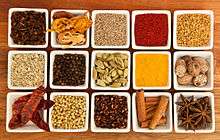Saraswat cuisine
 |
| This article is part of the series |
| Indian cuisine |
|---|
|
Regional cuisines
|
|
Ingredients, types of food |
|
See also
|
|
Saraswat cuisine is the cuisine of the Saraswat Brahmins from the Konkan region on the western coast of India. Saraswat cuisine differs from sub-Saraswat Brahmin sects and region. Saraswat cuisine originally hails from Goa, India. Goan Saraswat cuisine is known throughout the western coast of India. Each variation has its unique flavour and makes uses of different vegetables and fruits available in the region. Saraswat cuisine is strictly vegetarian, while in some sects it is pesco-vegetarian.
Lacto-vegetarian Saraswat cuisine
Their curries use a lot of coconut, coconut oil, tamarind, and curry leaves and the cuisine is largely influenced by South Indian cuisine. It is slightly similar to Malvani or Konkani and Udupi or Mangalorean cuisine. Their cuisine is less spicy and has less Portuguese cuisine influences than the cuisine of their Goan Catholic counterparts.[1] Hooman ani Xit (fish curry and parboiled rice) is the staple food of the Saraswat Brahmins of Goa, whereas the regular consumption of Indian breads such as puris, chapatis and parathas are seen mainly amongst the Saraswat Brahmin of Maharashtra, India. Satvik Brahmin (sub-sect of Saraswat Brahmins) cuisine is similar to Jain cuisne, which is a strictly vegetarian cuisine that does not use vegetables that are plucked from underground, such as onions, potatoes, garlic, etc. Dishes such as Savalem ranapp are prepared among the Bhats (Priests), Orthodox Goud Saraswat Brahmins and Chitrapur Saraswat Brahmins. This is followed by most Konkani families on Holy days and on festivals like Ganesh Chaturthi follow this style of cooking. On certain days (Mondays in particular), all Saraswat Brahmins eat only vegetarian food. This is particularly true in families whose Kuldev (family deity) or other family deities like Mangesh, Nagueshi or any other form of Lord Shiva. Most Saraswat Brahmins are routinely vegetarian.
Khatkhatem, a stew containing at least six vegetables, is popular. Other popular dishes include bhaji or shaak (made from different vegetables and fruit), usal (spicy pulses in a thin watery gravy), misal (usal topped with fried snacks), tondak (beans combined with cashewnuts), ross (coconut-based dishes), hoomans (different types of curries), karams (vegetable salads), nonche (Indian pickles) and papads (flatbread). Fast foods include Moongacho gathi (curried green gram), botatyache patal bhaji (potato curry), tur dal ross (split pigeon pea curry), etc.[1]
Chitrapur Saraswat cuisine
This is unique and its various forms have been published in the Ras Chandrika book both in Marathi and English. These are recipes that would have been passed down from mother to daughter or daughter-in-law. It is out of print and each copy is guarded zealously by the owner though at least one upstart has included them in a vegetarian cookbook. The cuisine consists either of curries and vegetables made with ground fresh coconut gratings or tempered beans, sprouts, pulses (dals) garnished with coconut gratings. However, nowadays, for health reasons, the use of coconut gratings is kept to a minimum. Typical Bhanap or Amchi (as the Chitrapur Saraswats refer to themselves) dishes are Batata Song (potatoes cooked with tamarind, onions, garlic, chili powder and turmeric), Kairus (ground coconut base with spices, capsicum, potatoes, tamarind, peanuts and cashews), sukke (ground coconut base, spices and a variety of vegetables like potatoes, knolkhol (kohlrabi), peas, cauliflower, okra) and ghashees and ambats, both coconut-based. Apinmedi pickle made with a certain variety of raw mango was a staple.
Pesco-vegetarian Cuisine
Some Saraswat Brahmins are pesco-vegetarians. The inclusion of fish in the diet is not looked upon as Non vegetarian. Legend has it that when the Saraswati River dried up, the Saraswats who could not farm, were permitted to eat sea food/fish. The fish were euphemistically called Sea Vegetable or झळकें from ( जल काय -Jal Kaay). Oysters for example are sometimes called 'samudra phalam' – sea fruit! L A typical Breakfast in a saraswat home may have included Pez (congee) of Ukdem Tandhul (Par-boiled rice) and Lonche (Pickles) and papad. Wealthier homes would partake of Dosa, Idli (in South Canara, Karnataka and other parts of South India) or Sannas (in Goa), along with chutney and or Sambhar. Shevaiyn phann or Phow (Gooda Phow or Meet Mirsange Phow) would be other breakfast specialities. Roties and bhakries also are types of bread eaten along with Tondak or seasoned batatabhaji (potato stir fry preparation). Lunch and dinner would have Daat DaliToi and rice (Xit pronounced sheeth) in a Dorke's home whereas Bhanaps would prefer Ambat with their rice for Kalvani. A typical Saraswat lunch would have Sheeth, Roass or Varann, in case it is non veg then it would be Hoomann, Bhaji, Tondak, Lonche, Papodd, and Toi or Kadhi. Kadhi is made to serve the dual purpose of Mukhashuddhhi (mouth purification, perhaps after all the relatively spicy stuff) and jeervonn (digestive Kadhis include asafoetida, Vomvom, Jeera, fennel seed). Sometimes the Kadhis are seasoned simply with Karivel and Sanswam (mustard seeds). Typically, this is a watery preparation which the luncher cups in his hand as it is poured onto his plate and drinks it before mixing a small portion of his rice with it to eat at the end of the meal. The most savoured as well as preferred Kadhis amongst the Konkani Saraswat Brahmins is the Kokumachi Kadhi or Konkam Kadhi. Kokum is a fruit found and grown within the western Konkan coast of India and is a speciality to every Saraswat cuisine. Formally it is often said that no meal is complete without Kokum Khadhi.
Notes
- 1 2 Sulekha Nair (Jan 18, 2009). "Goan delight". Financial Express. Express Group. Retrieved 2009-06-20.
References
- PHILAR, ASHA (2011). The Konkani Saraswat Cookbook. TERRA FIRMA.
- Mahalé, Padma; Sapna Sardessai (translated from Konkani) (2003). Ishtann: The Best of Goan Saraswat Cuisine. Printer's Devil. Cite uses deprecated parameter
|coauthors=(help);